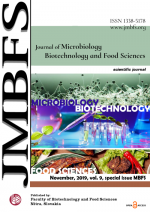MICROBIOLOGY SAFETY ASSESSMENT OF BRINE AFTER WET SALTING OF MEAT
DOI:
https://doi.org/10.15414/jmbfs.2019.9.special.431-433Keywords:
brine, wet salting, bacteria, CNS, colorAbstract
The aim of the study was to determine the microbial safety of brine and the effect of bacterial starter culture containing CNS strains of Staphylococcus carnosus and Staphylococcus xylosus (Indasia, Germany) on the microbiological quality of the brine during wet salting of the meat. In the first experiment was determined the microbial safety of brine with different concentrations of curing salt and with addition of bay leaf, whole black pepper; whole juniper and whole new pepper water extracts. In the second experiment were prepared brine samples with 9.5% of curing salt, brine samples with the same concentration of curing salt but with the addition of a starter culture and brines with the concentration 7.5% of curing salt, starter culture and spices water extracts same as in previous experiment. The commercial starter culture contains strains of Staphylococcus carnosus and Staphylococcus xylosus (CNS) was added in amount of 0.2g. Safety assessment of the brine was established according to results of pH value, salinity, color and count of coliform bacteria, psychrotrophic bacteria, Lactobacillus sp. and Streptococcus sp. The results show that the very presence of 9.5% salt and nitrite does not prevent the decline of microorganisms in brine samples used for salting meat. Protective culture helped reduce the number of unwanted microorganisms and promoted lactobacilli. However, the demonstrably higher antibacterial effect of the protective culture, determined on the basis of the number of psychotropic microorganisms, was found to be combined with the spice extract.Downloads
Download data is not yet available.
Downloads
Published
2019-11-08
How to Cite
Kročko, M., Ducková, V., Bučko, O., Bobko, M., & Tkáčová, J. (2019). MICROBIOLOGY SAFETY ASSESSMENT OF BRINE AFTER WET SALTING OF MEAT. Journal of Microbiology, Biotechnology and Food Sciences, 9(Special issue), 431–433. https://doi.org/10.15414/jmbfs.2019.9.special.431-433
Issue
Section
Microbiology
License
Copyright (c) 2022 Miroslav KroÄko, Viera Ducková, Ondřej BuÄko, Marek Bobko, Jana TkáÄová

This work is licensed under a Creative Commons Attribution 4.0 International License.
All papers published in the Journal of Microbiology, Biotechnology and Food Sciences are published under a CC-BY licence (CC-BY 4.0). Published materials can be shared (copy and redistribute the material in any medium or format) and adapted (remix, transform, and build upon the material for any purpose, even commercially) with specifying the author(s).





